How To Propagate African Violets in Water (The EASIEST Way By Far!)

Did you know there’s a simple way to start African violet babies from leaf cuttings? Here I’ll show how to propagate African violets in water!
There is something about African violets that is truly addictive. These amazing indoor plants will bloom all year round and their blooms come in thousands of different colors and designs (not to mention they can have several leaf shapes)! They are absolutely my hands-down favorite plant!
But when you find out how truly easy it is to start new baby plants, that’s when the fun begins! As a former online seller of African violets, I have done lots of experimenting with propagating violets in water and potting soil and I would love to show you my findings so you can get the best results!
If you have tried your hand at African violet propagation, you know the results can be more than a little disappointing – leaves that rot soon after you put them in soil, babies that die not long after sprouting, or separating baby plants too soon from the mother leaf. But with a few simple tips, you’ll have more baby violets than you know what to do with!
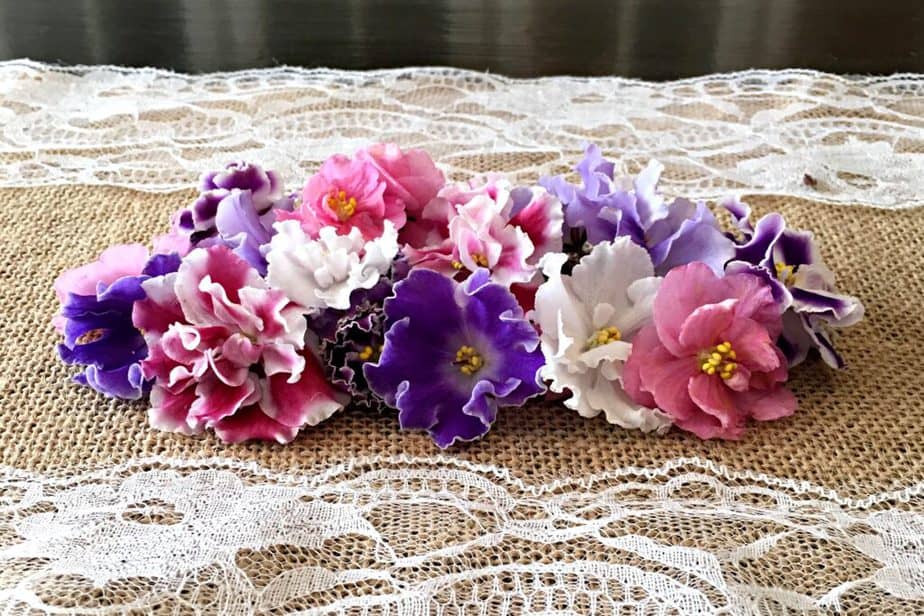
In this tutorial, I will share everything you need to know when it comes to propagating African violets in water. Not only will you be able to add to your collection but you can also buy leaves online of special varieties or trade leaves with a fellow plant lover.
In this tutorial, I’ll show you:
- How to propagate African violets in water (the most successful method!)
- Mistakes to avoid in the process of propagating violets to ensure you have good results every time
- Why starting violets from leaves is so much fun
- How to ensure your violets grow up to blooming, thriving plants
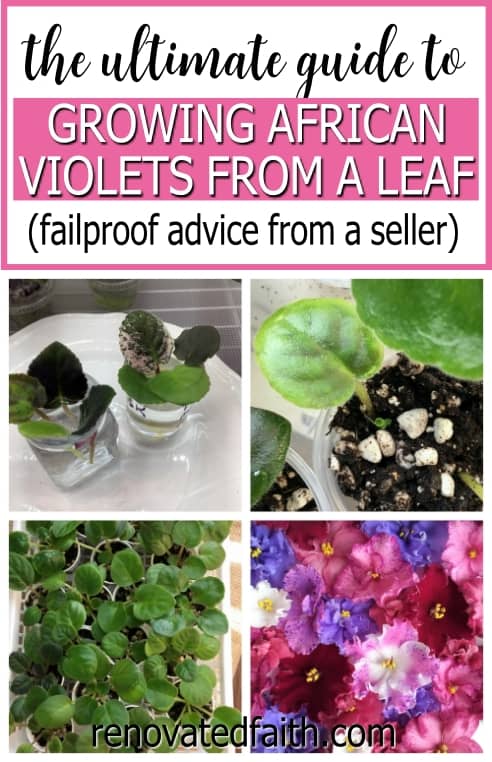
What I love most about African violets is starting out baby plants from leaves. It is exciting to see tiny leaves pop up from a leaf and eventually bloom for the first time! Because this is my favorite aspect of our hobby, I’ve had a lot of practice to show you how to grow an African violet from a leaf.
If You Propagate An African Violet Using Leaf Cuttings, Will The Daughter Plant Be The Same Bloom Color As They Original?
For African violets (saintpaulia ionantha), baby plants coming from the parent plant’s leaf will most often look just like the parent plant. There are a few occasions where the baby will look different and this is called a sport. But the vast majority of the time, they are identical.
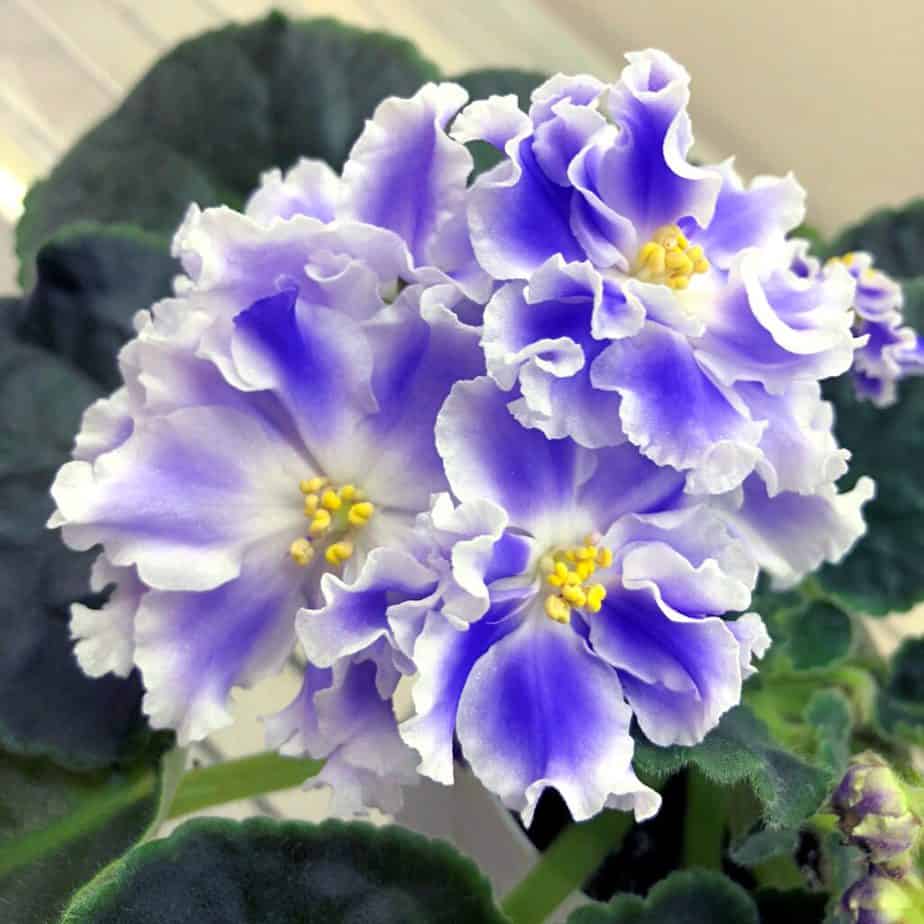
My Experience with African Violet Propagation By Leaf
I actually had an African violet business where I sold thousands of African violet babies online. It was a lot of fun because I got to see so many new varieties bloom for the first time. It was like having my own little Christmas every day when I checked my light stands!
Because I’ve had plenty of practice with propagating African violet leaves, I’ve experimented with all the different methods – propagating African violets in soil only, propagating by flower stems and by seed. The specific method of propagating African violet leaves in water has consistently yielded the most healthy babies that are true-blooming! I have had so much good success with this method and I’m excited to show you how to propagate violets too.
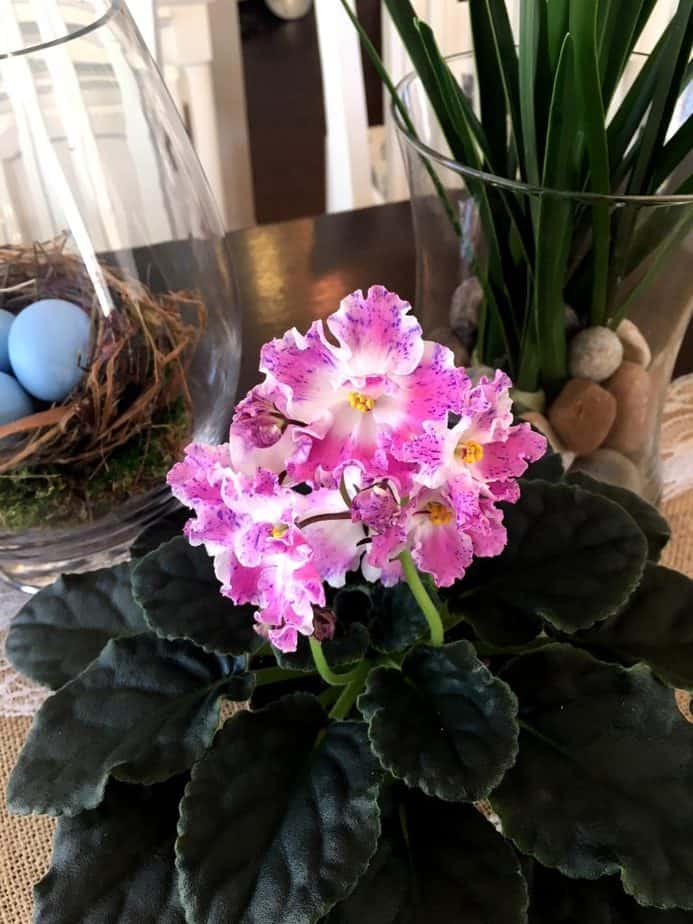
Methods of Propagating African Violets
- African Violet Seed Propagation – This technique is most commonly used by hybridizers where a plant’s bloom is polinated with pollen from another plant. African violet propagation by seed is very time-consuming as takes twice as long as starting african violet cuttings in water.
- Crown Propagation – This is done by chopping off the main stem or crown of the plant with a sharp knife. After a few weeks, little plants will start to grow from the cut crown. This is often used to start a new chimera plant or to restart a plant suffering from root rot.
- Suckers – This method of African violet reproduction occurs when a side-shoot or sucker is cut away from the crown of an adult plant.
- Bloom stalks Propagation – Propagating African violets from flower stems is done by rooting the flower stalks in water or soil to reproduce genetically identical plants like chimeras. Of all the different ways to propagate african violets, this method is most difficult and takes a long time.
- Propagating African Violets in Soil – Many people put their leaf cutting straight in the soil. However, leaves can easily die from root rot with this method.
- Propagating African Violets in Water – The easiest and fastest method of propagating African violets!
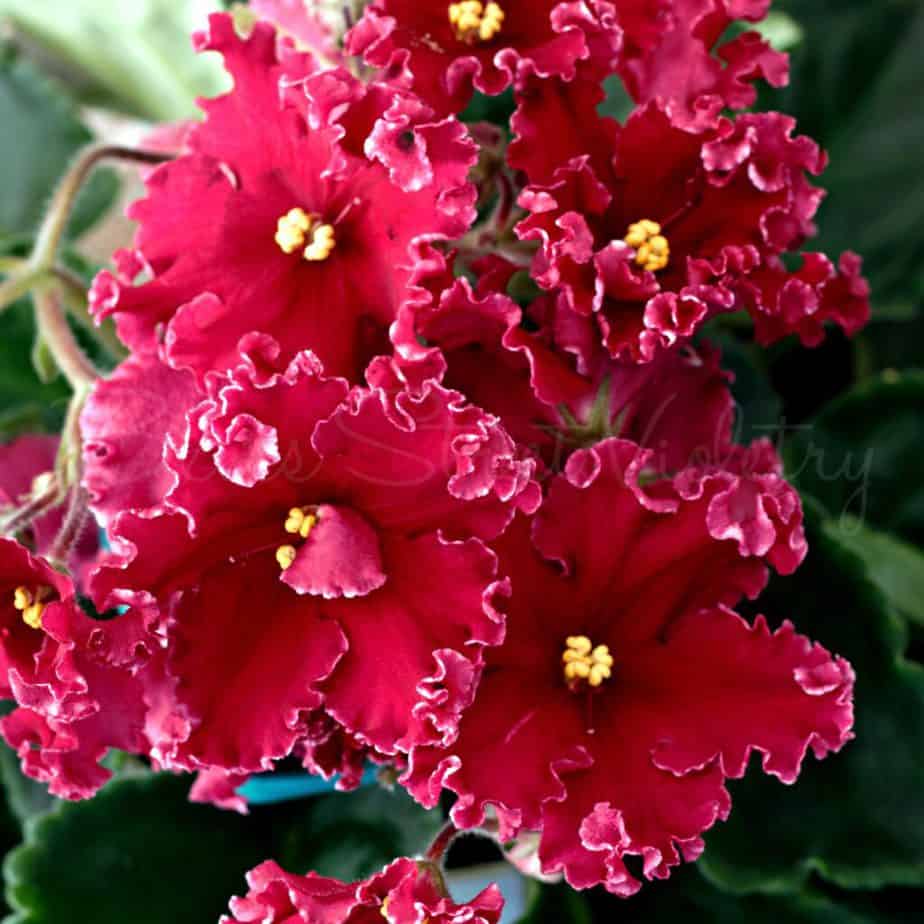
African Violet Leaf Cuttings – Why My Healthiest Plants Are the Ones Started From Leaves
All of the African violet plants on this stand were started from leaf cuttings: DIY Grow Light Stand with LED’s
When you start a plant from a leaf cutting it thrives because it was started in the same culture. Plants in general but especially African violets, don’t like change. When you buy a mature plant from a seller or home improvement store, that plant was grown with different soil, humidity, ph, and lighting than your own surroundings. That’s stressful on a plant. That’s why plants started from a leaf grow better because they are grown in a consistent culture.
With this method, I’ve gotten anywhere from 3 to 40 babies from a single leaf!
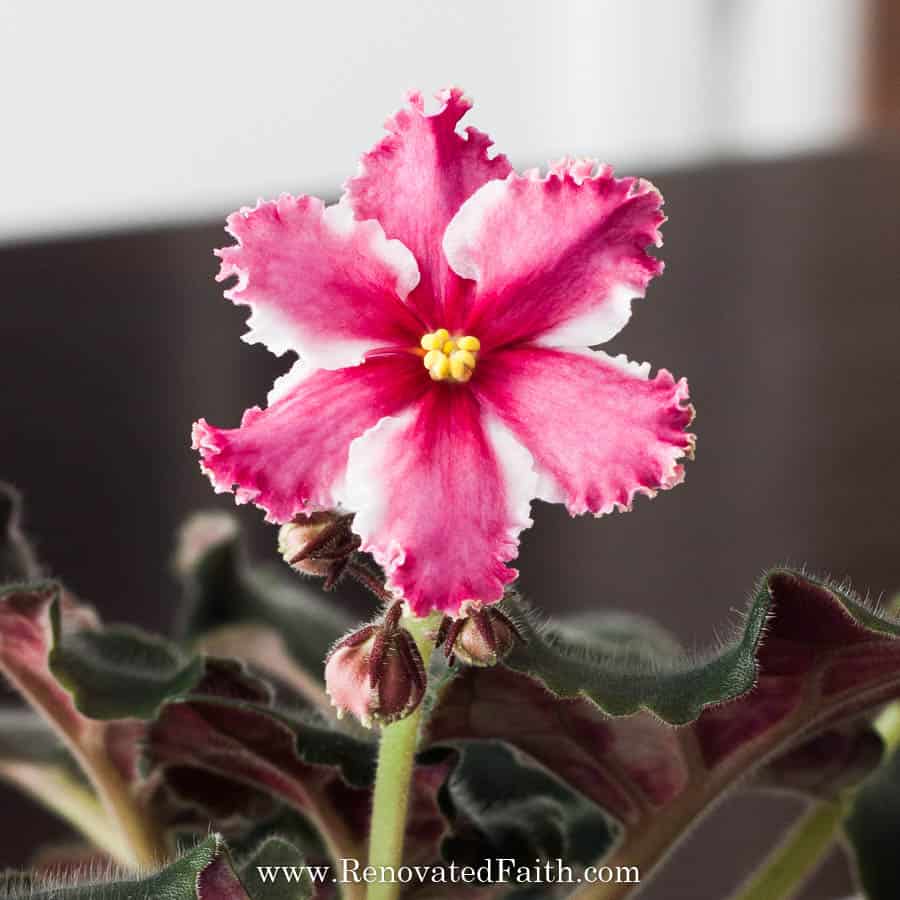
When to Propagate African Violets
African violets can be propagated any time of the year since you will be growing the new plants indoors. Unlike most flowering plants, African violets all year round so you can enjoy their flowers non-stop!
Renovated Faith: What’s In A Name?
So many of my DIY projects remind me of God’s capacity to transform our brokenness and renew our hearts. If you are a work-in-progress, just like I am, check out the Renovate Your Faith Devotional at the bottom of each DIY and home décor post. Click here to get a weekly reminder of new posts by adding your email address.
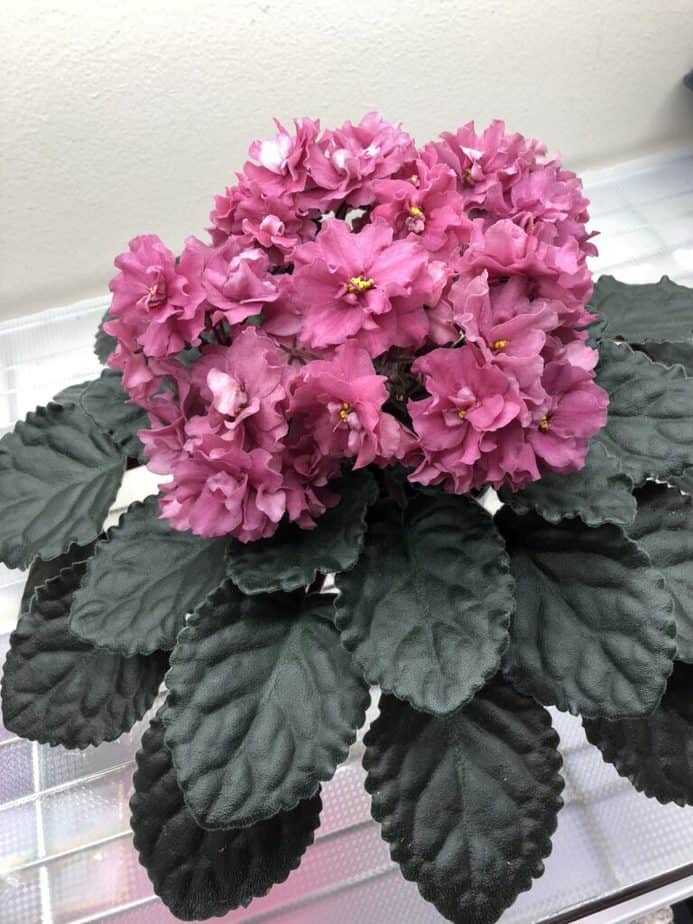
Supplies for Propagating African Violets in Water
African Violet Leaf
African Violet Soil – Most of the soils sold in stores are too heavy with organic matter. My favorite growing medium is from Hunter’s Hybrids. I use Ken Muzalewski’s Wicked Wicking Mix on leaf cuttings and all my mature plants. You can message him on Facebook at Hunter’s Hybrids to order. Another option is buying African violet potting mix at a local store and add perlite so it’s a 1:1 mixture of soil to perlite.
Distilled Water – Baby plants prefer the Ph neutrality and it makes a big difference when propagating African violets from leaf cuttings
Small Clear Glass Jars or Candle Votives – Really any types of small clear glasses will work but I use glass candle holders
Clear Plastic Containers – If you are using just one or two leaves, you can use a clear plastic bag
Saran Wrap
Sharp knife
Spray Bottle of Water and Bleach – Mix the water and bleach at a 10:1 ratio.
Sharp Scissors
Scotch Tape
Plastic Condiment Cups – I find these work really well for babies sprouting from the mother leaf: 4 oz. Condiment Cups
3 oz. Solo Cups – These are the little white ones.
Plastic Spoon
Squeeze Bottle
Sharpie Marker
African Violet Fertilizer – The only fertilizer I use on my African violets is Hunter’s Hybrids fertilizer and my plants love it. You can message Ken on Facebook here to place an order: Hunter’s Hybrids Fertilizer
For Young Adult Plants : Acrylic Yarn, Plastic pots, Jars with mouths that will fit the pots
How To Select A Leaf From The Mother Plant
You’ll have the best chance of getting lots of tiny plants if the mother plant has healthy leaves. African violet leaves start from the center of the plant and keep moving outward as the plant grows. The newest leaves are in the center and the old ones are on the outside. Eventually, the last row of old leaves will shrivel up as it’s just a natural part of how the plant grows.
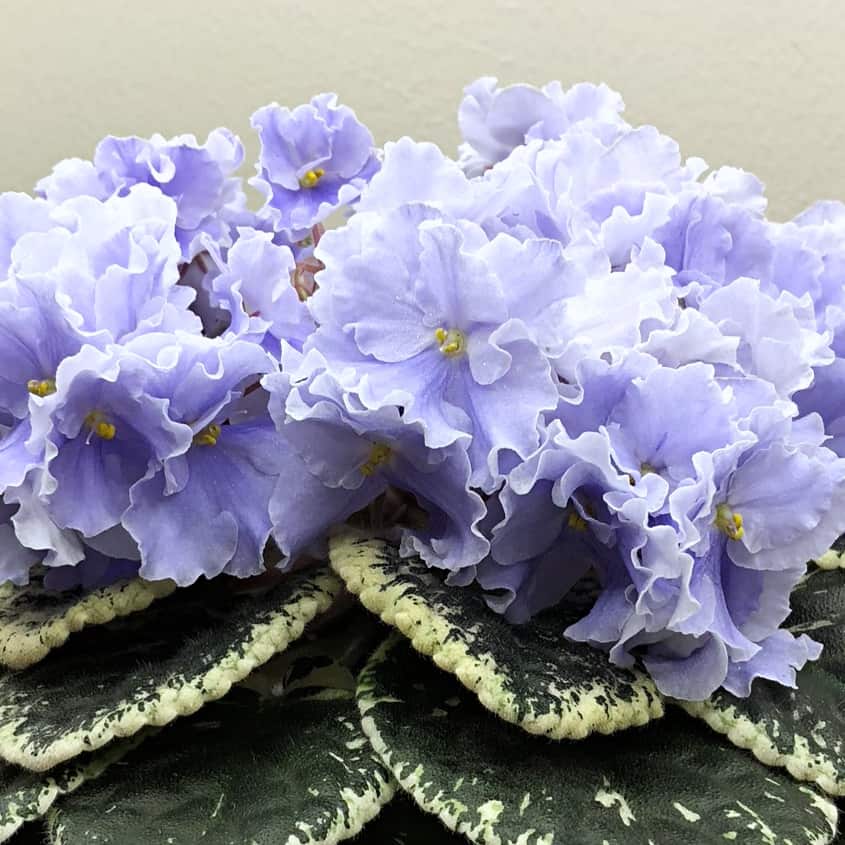
You can get the best leaves for propagation by picking from the original plant’s second or third row of leaves (looking from the center out). You want to pick from green leaves that are big enough to propagate (no brand new leaves from the center), but you don’t want a leaf on the last row that may be about to die. If the only leaf you can get is one from the last row, that’s perfectly fine. It should yield at least one baby for you!
When you take a leaf off of a plant for propagation, be sure to take the leaf with the entire leaf stem (also called the leaf petiole) that runs to the base of the plant. Put it in a baggy with no extra air to keep it hydrated until you can put it in water.
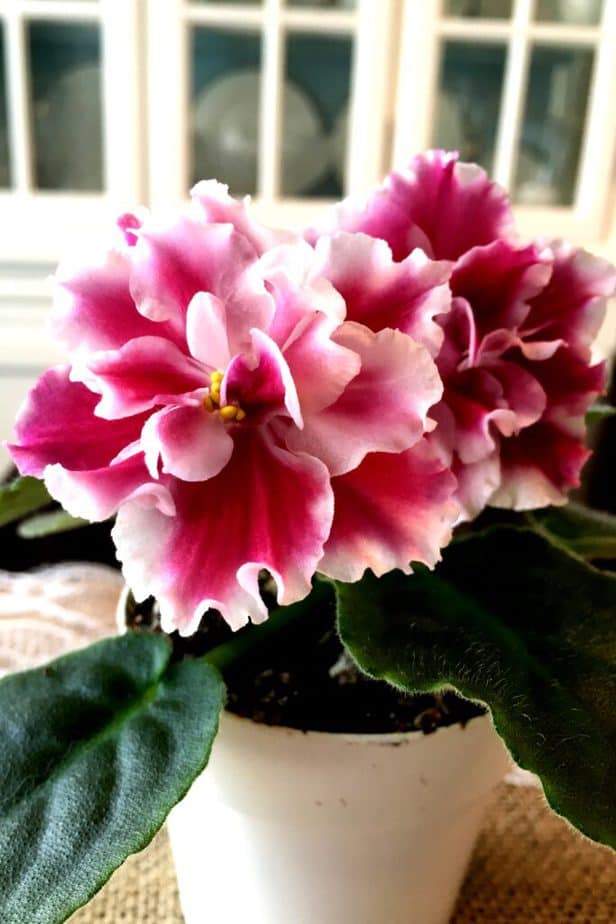
How To Grow An African Violet From A Leaf – What To Do When You Get It Home
When you get a leaf home, you want to ‘sanitize’ it to ensure you don’t run the risk of bringing in any unwanted pests, eggs, or fungus that can infect your entire collection. It sounds crazy but it happens. Unfortunately, African violets are a little more susceptible to pests than most houseplants.
Spray your leaf with the 10:1 water/bleach solution. Let it sit for a 5-10 minutes before rinsing it off.
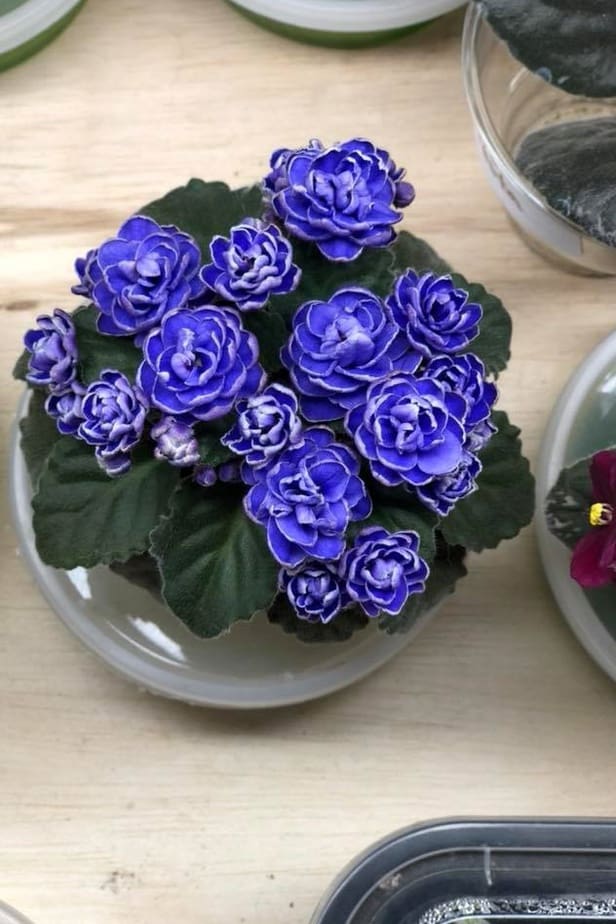
How Do I Propagate African Violet Leaves That Are Wilted Or In Bad Shape?
Translucent or Brown Spots – If the leaf has significant damage, it’s best to trash it to avoid contaminating your collection. If you have just a few spots that you know are cold damage, cut off those spots to keep them from spreading.
Limp Leaves – Why do African violet leaves get limp? Sometimes you will get a leaf in the mail that is completely limp. That means the leaf has lost moisture and it can’t maintain it’s vascular structure. The good news is that as long as it is still green, you can save it!
In a bowl of lukewarm water, add about 2 teaspoons of sugar and 2-3 drops of SUPERthive. Mix well. Add the limp leaf to the bowl and completely submerge it. You can also put the bowl in a bright place (Click HERE for my post on how to grow plants with LED lights).
You can soak your leaf in this mixture anywhere from 30 minutes to overnight depending on its condition. This mixture hydrates and gives extra nutrients to the leaf to ensure that lots of babies will start from it.
Before you know it, your leaf will look as good as new. By using this method, I’ve never lost a dehydrated leaf. When you are done, rinse the leaf and gently pat it dry.
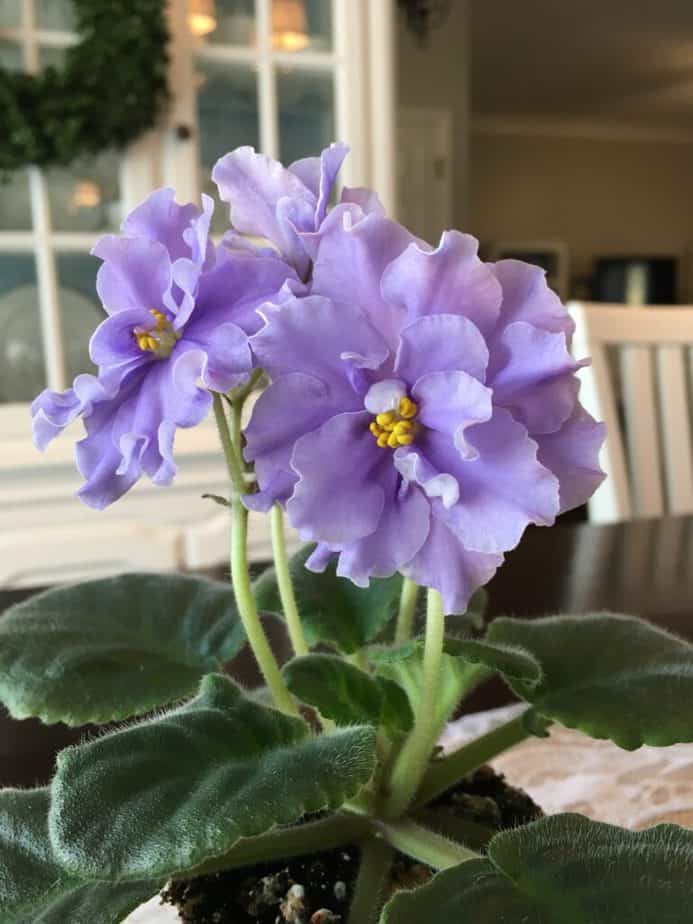
How To Propagate African Violet Leaves in Water – The Easiest Way
Step 1: African Violet Propagation Prep
When you are ready to propagate your African violet cuttings, you should first cut the base of the stem from wherever it’s already cut. You want to have a stem that is about one to two inches. Be sure to use a sharp knife and cut at a slight angle for faster production of roots.
What About Using a Rooting Hormone?
Using a rooting hormone with this method hasn’t made my plantlets grow any faster. Also, a rooting medium can sometimes call genetic changes with African violets.
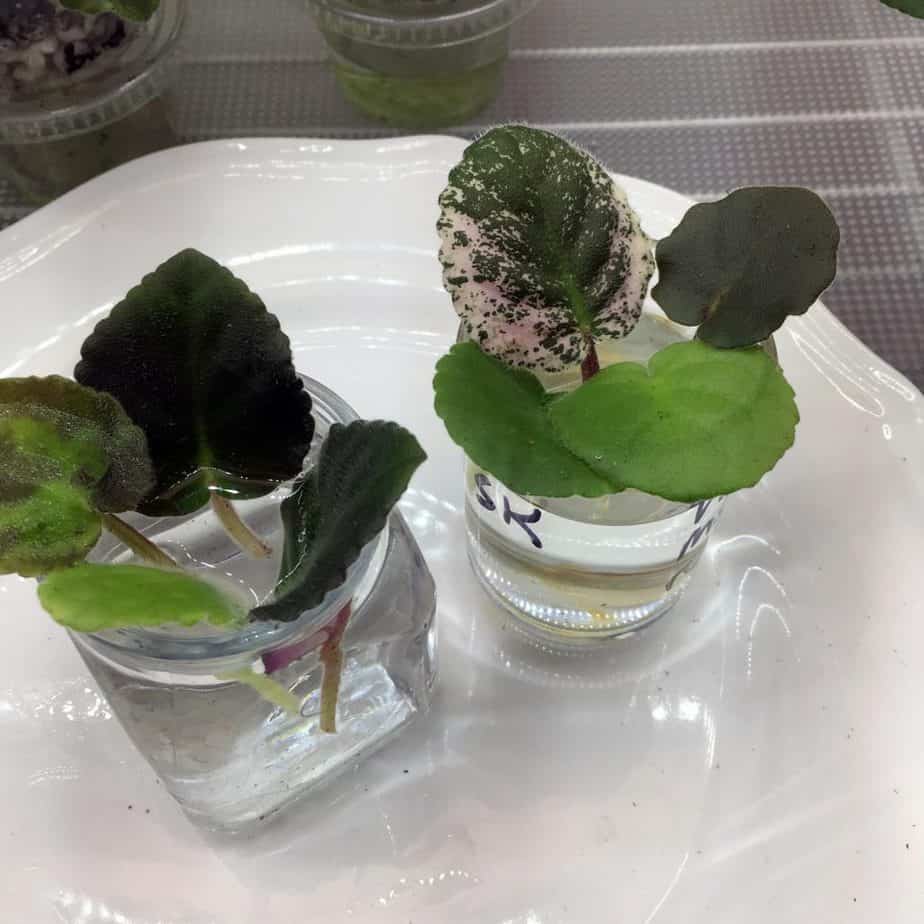
STEP 2: How to Propagate African Violets From A Leaf in Water
Once you have a healthy leaf, you can “put it down”, which means creating a culture where it can put down roots.
Rinse the “soaking solution” off your leaf. Spray your knife with the 10:1 water/bleach solution to get a clean cut. Then cut your leaf so it’s about an inch to 2 inches long and at a 45-degree angle. ( The angled cut ensures more surface area for babies to grow.)
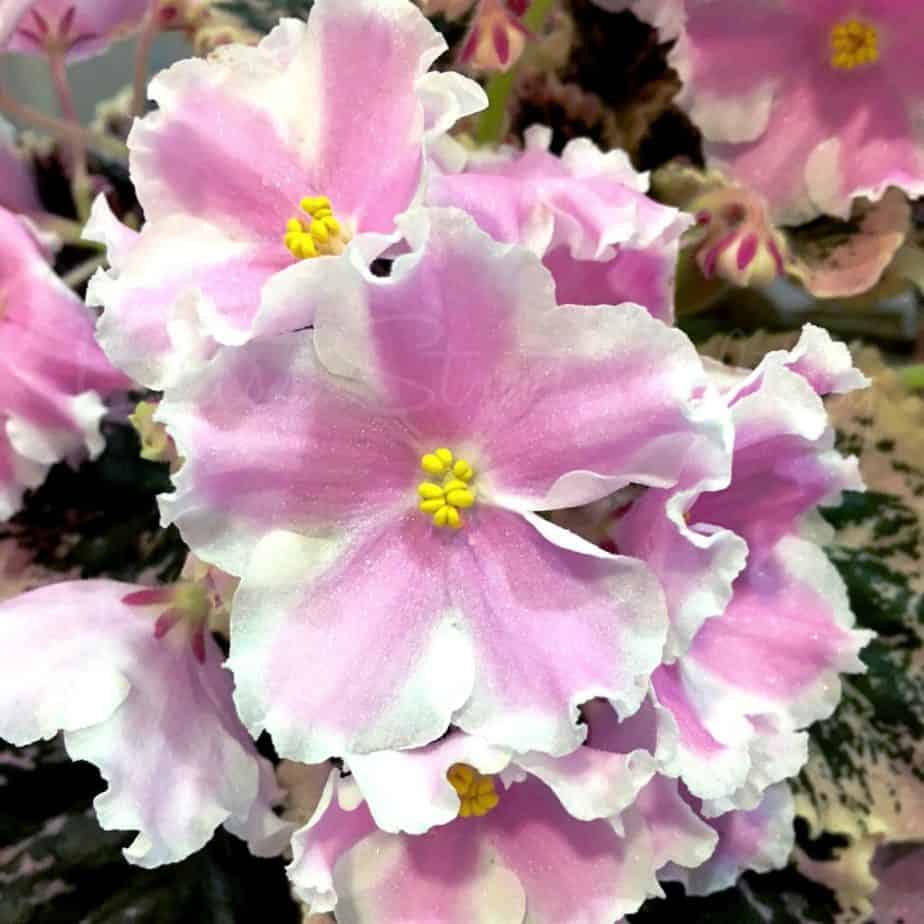
Where to Grow African Violets – Lighting Tips!
Now, put the leaf in water and wait for roots to start. African violets can handle bright light as long as it’s not too hot. That’s why LED lights are preferrable to sunlight or fluorescent lights. You can put your violet leaves in water in a northern or eastern-facing window ideally or on a light stand like this one I built: Easy DIY Grow Light Stand.
I prefer this method of rooting African violet leaves in water initially to putting the leaf in soil initially. With African violet leaf propagation in water, the leaves will take longer to start roots, but if you compare a 6-month old baby started in water to a 6-month old baby started in soil, you will see that the one started in water is a larger, healthier plant.
I like to use glass candle votives to start roots. Just add lukewarm or room-temperature water (they don’t like cold water) to each glass candle holder and set each mother leaf inside. You can write the plant name on the side with a Sharpie and the writing will disappear in the dishwasher. (I use distilled water because our tap water has a very high PH.)
One of the major advantages to rooting African violets in water is that this method keeps the stems from rotting. I realize that it seems like they would be much more likely to rot but I’ve seen this method work time and time again!
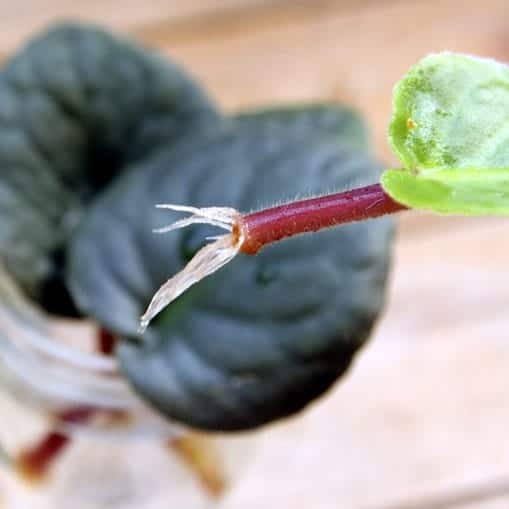
Rooting Process Duration
Rooting an African violet takes about 14-18 days depending on the time of year. When the roots are at least ¼ inch in length, it’s time to put the leaves in the soil!
Step 3: Moving Your Rooted African Violet Leaf to Soil
African violet water propagation is the fastest way to get roots started but now those roots need soil to start baby plants.
When you see new roots forming at the bottom of the leaf stem, let them get about 1/4 to 1/2 inch long before transplanting them to soil.
When it’s time to plant your rooted leaf in soil, punch about 4 small holes in the bottom of each 4 oz condiment cup. This is important to allow any excess water to train out so the leave does not rot.
Fill the bottom of the pot three-fourths high with your African violet soil mix. Again, be sure to get the soil mixture mentioned in the supply list or mix store-bought soil in a 1:1 ratio with perlite. This ensures a really light mix that doesn’t hold onto too much moisture. Propagating African violets is really difficult if the soil is damp and that can easily happen with peat moss-based soils.
I feel like leaves start babies faster when they are in the presence of other rooted leaves, so I put two or three leaves in each cup. Be sure to label them well.
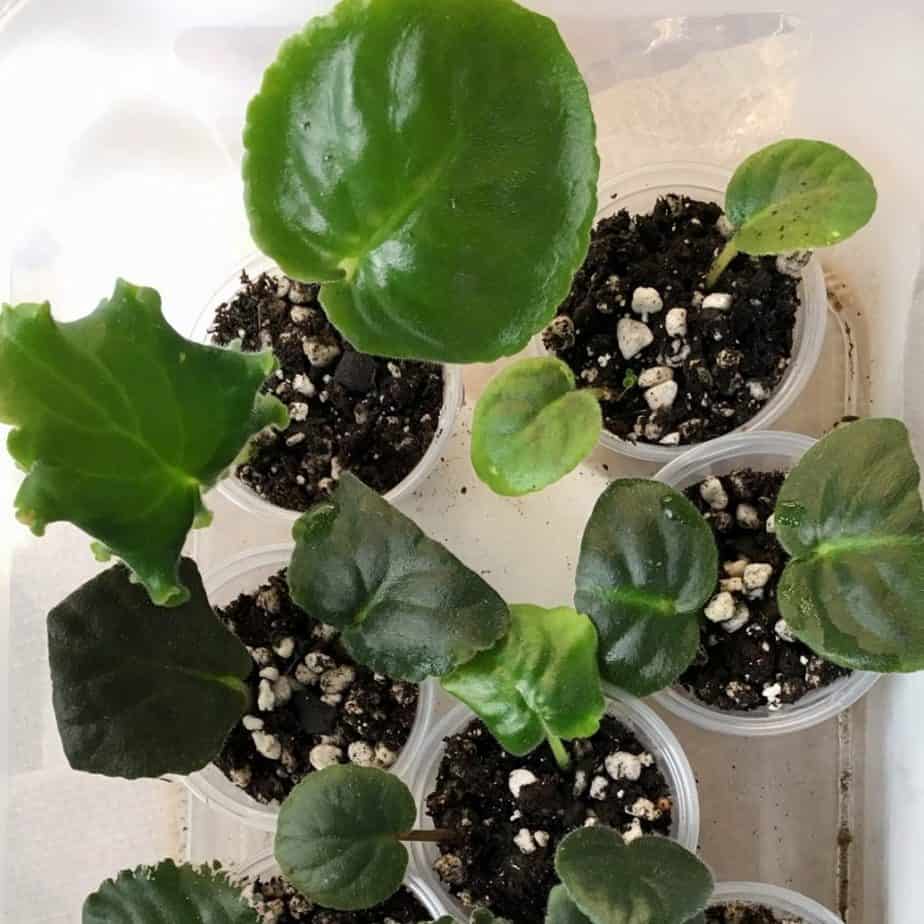
Don’t push down the soil in the cup. You want the soil to stay light, loose and airy. Place the cut end of the stem just under the surface of the soil so it just covers the base of the leaf. Lean the leaf stem against the edge of the pot or cup for support. Make sure the leaf is fuzzy side up.
Water the cup just slightly so it is barely damp and then squeeze the cup a couple of times to help aerate the soil. (I water leaves and babies with my usual fertilizer water which is 1/8 tsp of the Hunter’s Fertilizer to a gallon of water). Tilt the cup to get any excess water to pour out of the drainage holes.
The number one rule is to not let the soil get too wet. It should be just damp, comparable to a wrung-out sponge. Usually, the leaf pots that I somewhat neglect are the ones that do the best because they are dryer! (You can also use course vermiculite instead of soil if you are concerned about over-watering. The leaves will get their nutrients from the fertilizer in your water.)
I like to put all of my leaf pots in plastic containers with some saran wrap over the top. This makes a mini greenhouse which is essential because African violet babies love a humid environment. You can use scotch tape or a rubber band to keep the saran wrap on top of the container. (If you are only potting up one or two violet leaves, you can put the cup and mother leaf in a clear plastic baggie and vent one corner.)

Humidity Is Your Friend When Propagating African Violets
Once you put the saran wrap over the top of your container, vent it slightly on two corners. You want to see tiny mist-like water droplets on the inside of the saran wrap. Leaves thrive in a high humidity environment. However, if you see large water drops, you want to vent the container a little more. Humidity is great for plant growth but it’s possible to have too much of a good thing!
How often should I be watering an African violet leaf?
After a couple of weeks, check your leaves. I like to use a pipette or squeeze bottle to add a few drops of water to each container. Remember they need very little water as the mini-greenhouse will retain a lot of moisture.
Babies will start to appear after a few weeks. This is where some patience is required!
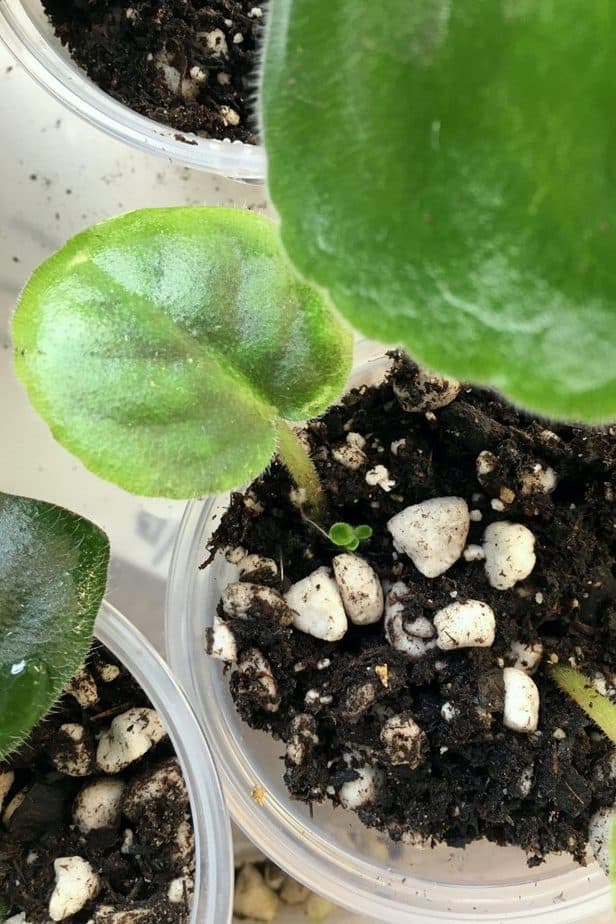
“Motivate” Babies to Grow
After I start to see baby leaves, I begin weaning the babies off the mother leaf. Every two weeks when I water them, I also cut a tiny sliver off the top of the mother leaf until the top half of the leaf is gone. This does a couple of things: For one thing, it causes the baby to depend less on the mother leaf. Also, when the leaf is cut, it releases a small puff of Ethylene gas. To make it simpler you can also just cut off the top half of the leaf when you put it in water.
\When plant cells are broken or cut, they release ethylene gas. In nature, this seems to be a signal that a predator is feeding. Theoretically, the plant responds by increasing the rate of photosynthesis to survive. Therefore, the babies respond to the ethylene gas by growing faster.
Every two weeks, I also slightly squeeze each of my leaf pots. This helps to stimulate the roots and aerates the soil.
When Do You Cut Away the Mother Leaf?
Soon, you will see more and more babies sprouting up! When the baby leaves are mostly green and most are larger than a dime, I cut away the mother leaf. I do this by using my scissors to cut off the leaf at the step just above the top of the soil.
How To Grow African Violets From Leaves A Second Time
Now that the mother leaf is cut away, continue to put your leaf pots in the mini greenhouse, checking their moisture every couple of weeks.
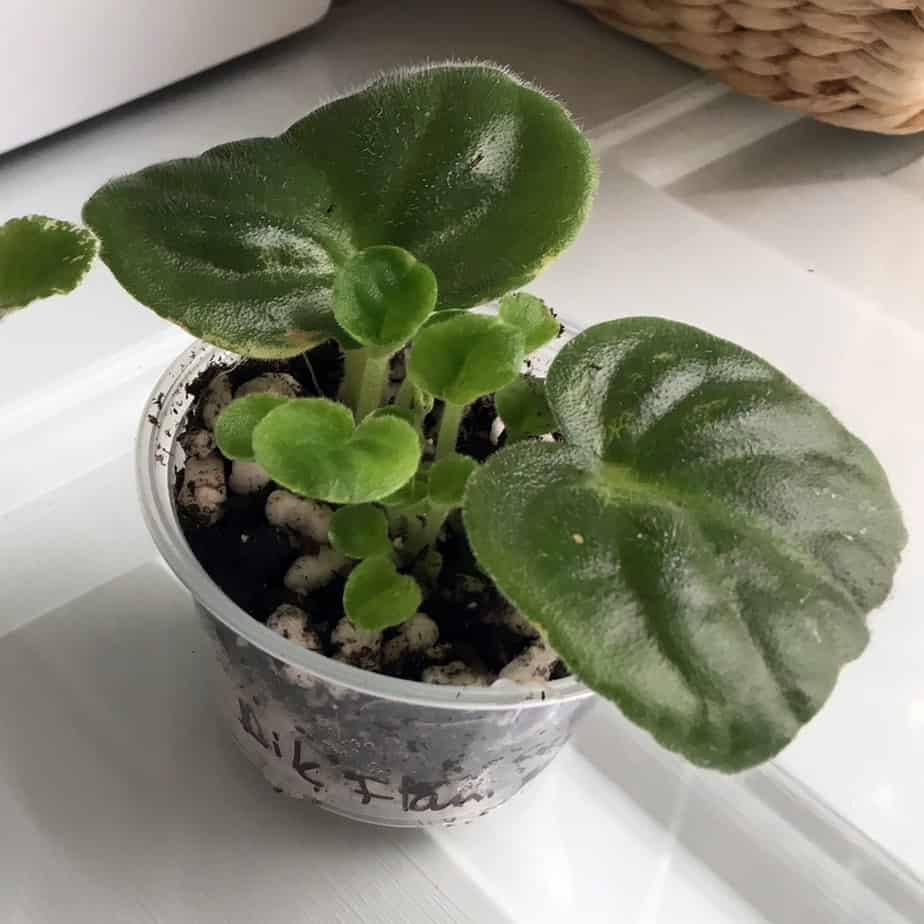
Step 4: Separating and Planting African Violet Babies in Pots
When should I divide my African violet babies?
I like to separate the new plantlets into their own pots when most of the baby leaves are the size of a quarter. If the babies seem especially cramped, I separate them sooner and plant them in 3 oz. solo cups that work great as small pots.
Take your time and be very careful separating the tiny plants from each other. I like to separate the leaves and leaf stems first and slowly separate the roots next.
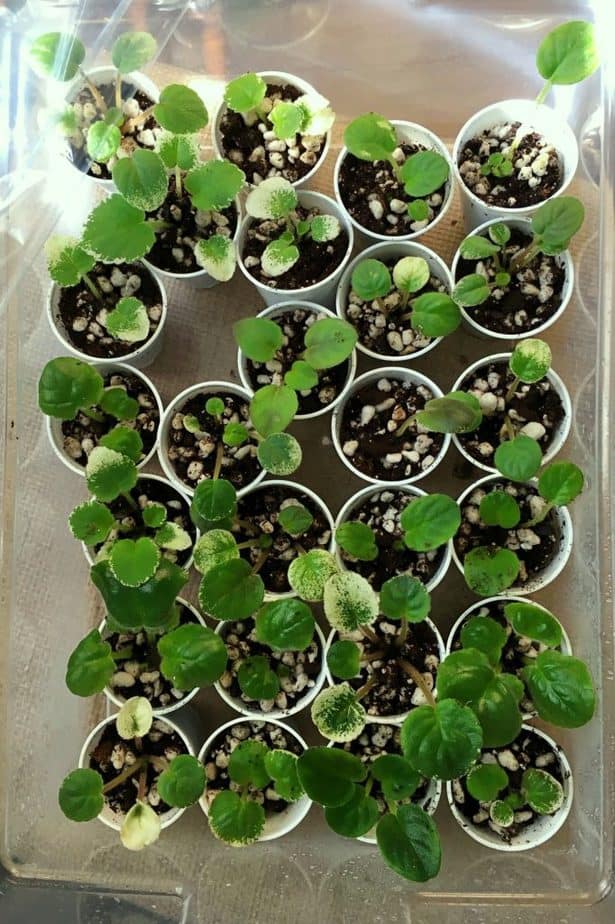
I like to put my separated babies in a container with saran wrap similar to the leaf pots. When they have established stronger root systems, I slowly start to pull away the saran wrap to acclimate the small plants to normal humidity. Then I wick them and put them with my other plants.
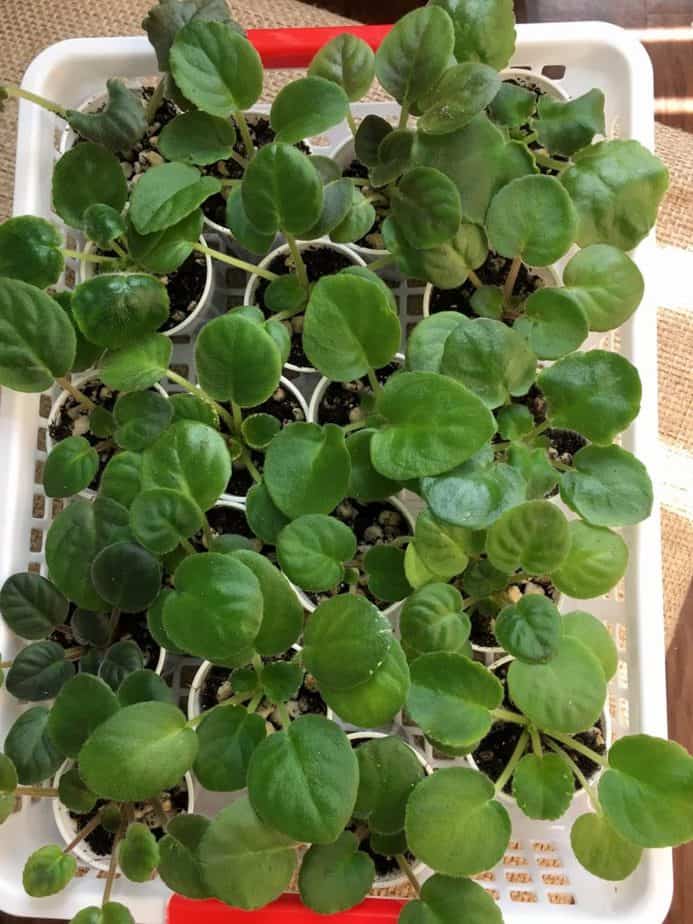
African Violet Care: Is It Hard To Grow African Violets?
After your baby violet has gotten too big for its cup, you’ll want to transfer it to a larger pot. Violets like to be in pots that have a diameter that is 1/3 the diameter of the plant from leaf tip to leaf tip.
African violets have a reputation for being the drama queens of the plant world, but honestly, they are by far the easiest house plants I own! Once you know what they like, they are extremely low-maintenance!
How Often Do You Water African Violets?
Use the same potting mix you used before repot your plant in a slightly larger pot. Because African violets love wick watering, this is the point where I will feed a piece of yarn (like this) through the bottom of the pot, and up to the top edge of the inside of the pot. Water will wick up slowly giving your plant continuous water at a rate it needs. You only need to worry about watering your plant when the reservoir at the bottom is empty.
I like to set my African violets in the tops of jars (like these) or you can also use plastic African violet reservoirs (like the ones shown here).
Do African Violets Need To Be Repotted?
African violets like new soil every six months to a year. Often by this time, they will need a larger pot anyway.
As far as their lighting needs, African violets like light that is not hot. They can handle bright light from a bulb but bright sunlight scorches their leaves. So, you can have your plants on a lighted plant stand like this one I made or you can put your plant in a window that gets sunlight but not direct sun.
If you want to know more about African violet care, my favorite book You Can Grow African Violets by my friend Joyce Stork. You will know find anyone that knows more about these plants than she does. You can also find tons of great tips and articles at avsa.org.
Related Posts on HOw to Propagate African Violets in Water
African Violet Cuttings for Sale
Stunning DIY Light Stand for African Violets
LED Lights vs. Fluorescent Lights for African Violets
31 Easy DIY Landscaping Ideas on A Budget
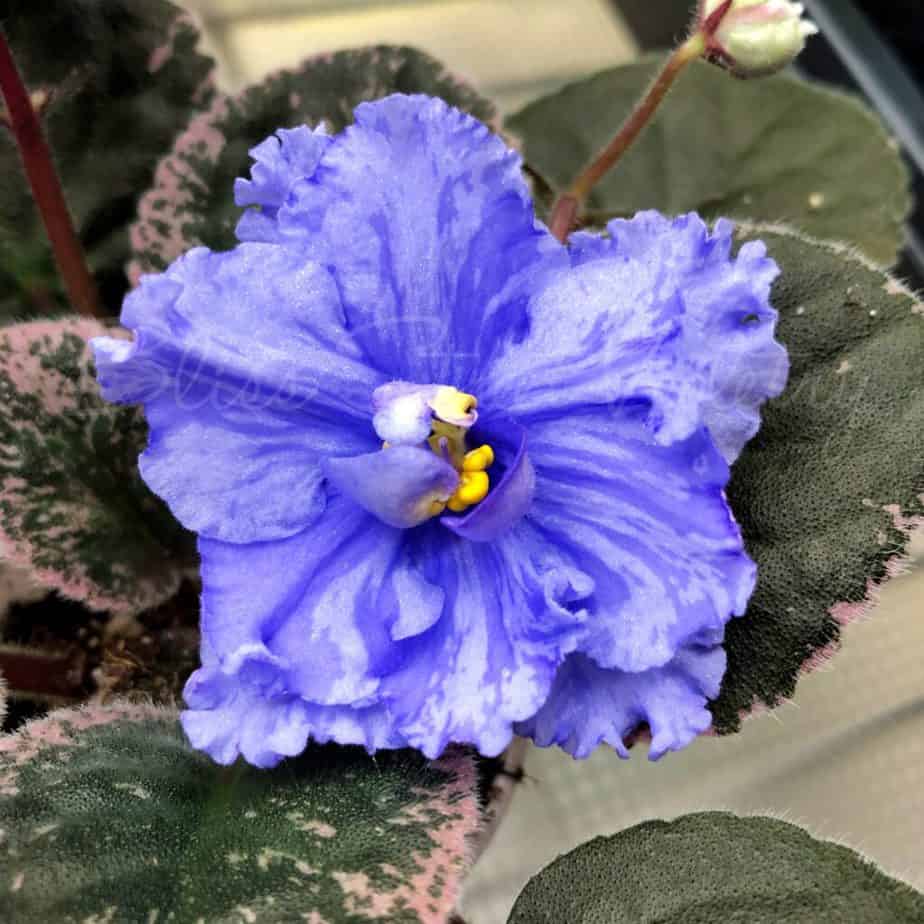
Troubleshooting Tips for Propagating African Violet Leaves in Water
What if the baby leaves are mostly white? In my experience, these leaves green up as the plants get older but you can also add Epsom salt water to speed up the process. Add one tsp of Epsom salt to a gallon of water and water as normal.
What is the white powdery substance on my leaves? That is most likely powdery mildew. I like to use Lysol spray (do not use the off-brand – ask me how I know!). Spray it in the air above the leaf. Then, let the spray drift onto the leaf. This will kill the powdery mildew and prevent it from coming back.
Why do my leaf’s roots look thick and gnarled? Your soil is too moist. Let it dry out a little.
Final Thoughts on Propagating African Violets in Water
As a former online seller of African violets, these are my best tips on how to grow African violets in water. After lots of experimenting, this process has worked for me time and time again without fail. Follow these easy steps and you will have blooming young adult African violets before you know it!
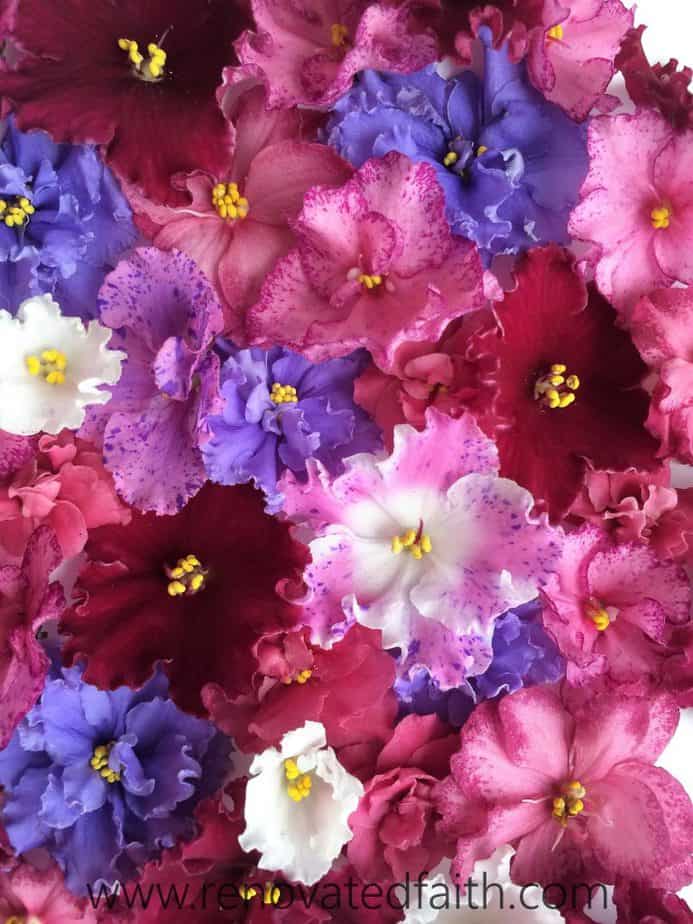
If you want to save this post for later, pin it here:
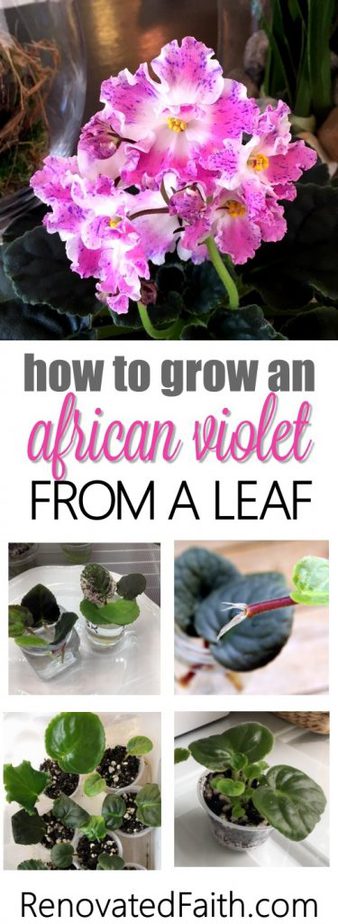
Blessings,

You can follow Renovated Faith Below!
Email Subscription to Renovated Faith | Instagram | Pinterest | Facebook | Twitter
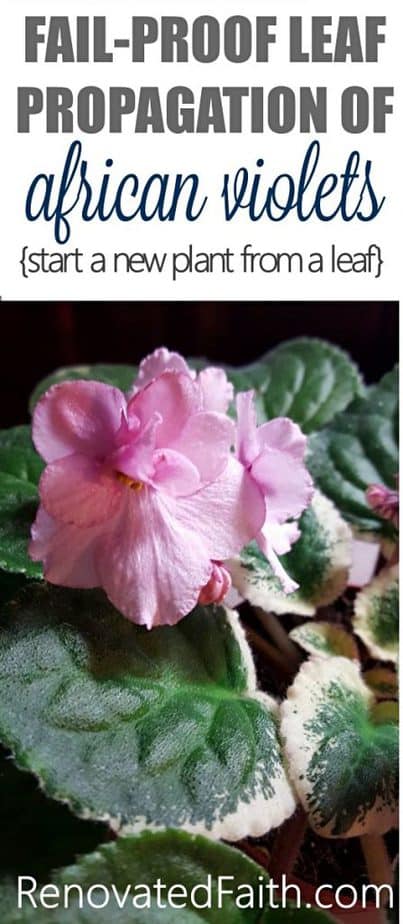
Best Tips for Propagating Violets in Water

Karin Peters is a DIY expert and the creator of Renovated Faith. She is a furniture painter, a home design consultant, and a tenacious problem solver determined to help you transform your house into a home. With 17 years of experience with DIY home improvement, she researches and analyses professional processes to adapt them to be easy and cost-effective for DIYers. She then tests every project and product before it appears on the site in a detailed, step-by-step format. After attending Texas A&M University, she received her Master of Divinity with Biblical Languages at Southwestern Baptist Theology Seminary. Her passions unite in Renovated Faith, which shows readers how to create a home that serves them so they can pursue their God-given purposes. About Renovated Faith | Editorial Policy | Facebook | Twitter | LinkedIn

Muchas gracias por los consejos son muy útiles para estás pequeñas hermosas y sus cuidados a partir de la reproducción en agua seguiré tus consejos tienes alguna plataforma para ver tus vídeos tutoriales etc. Saludos desde México bendiciones
Thank you for taking the time to write all this out! I’m new to AVs and tried propagating a few leaves a month ago. So far 2/3 have started roots, but one is having trouble – no roots after 4 weeks and the leaf is starting to droop. Do you have any advice on how to save it? It was in moist soil (1/2 perlite). Since there are no roots yet, should I cut off a little bit more of the stem and try water propagation?
Lydia, That’s exactly what I would do, recut it and put it in water again to try to restart it. Have a great week!
Thank you for this article. I have been learning about African Violets for the last 1½ years & I finally have blooms, lol. So now I’m going to try propagating leaves. 🙂
It is such a rewarding hobby! Thanks for your kind comment Susan.
I’m glad I found you. Been trying to learn about African Violets . I was told by a friend the water method and now have roots. I was checking what to do after the roots as I thought no babies will form in water. Searching made me find you. Very helpful. Thank you. I will be coming often when in doubt. I’ve learned some new things reading your article. Thank you.
I have babies growing on the roots that are in the water. Hehe. Shall I pull them off and repot or just repot the mother and babies will grow up from the root and through the soil?
Hey MaryLynn, Just leave the babies on the mom and plant the mom shallow-ly so the the little leaf tops are just poking obove the soil. It they do get covered with soil, they will eventually break the surface. I hope this helps!
I have water propagated two African Violet stems and they have been in water for over three months👀They have very long roots(4/5 inches) and tiny little plants.How should I plant them in soil?And,should I trim the roots?
Hey Wanda! Don’t trim the roots. Just put them in a pot with moist AV soil and make a little greenhouse for him like I mention at the end of this post. Let me know if you have any other questions!
I have been growing all kinds of plants for years , but African violets are my favorite.
now I have a four plants where the bottom leaves have turned mushy because I used cold water from the garden window where the plants grow, to water them. I want to repot the plants which have an inch or longer stem after I removed the wet
leaves from the bottom. Can I repot the plant and putting the stem all the way in the soil to root?
The top of the plant looks just fine and green an healthy.
Hey Verna, This video from my friend Joyce will show you exactly what to do: https://www.youtube.com/watch?v=KE0_d_E6NMk
I got some leaves from my elderly neighbor and I put them in water.
But nothing is happening the leaves look just normal nice healthy color and sweet and fluffy. It’s been 4weaks now and still no roots. Can you please help me with this issue. I would love to show that her leaf cuttings grow up to be healthy plants.
kind regards Andy
Hey Andy, As long as they are green, just let them sit. They will sprout roots eventually. Give it another week or two and let me know if they haven’t sprouted by then. Blessings, Karin
Best info ever read. I do usually loose the babies when put in soil in solo cup. Will add the perlite next time to make it lighter. Thanks for excellent article.
Thank you so much Peggy! I really appreciate that!
Love all the advice. Now down on my knees and hope I’m going to be successful with my propagating of my African violets. 🦄
Thank you so much very usefully information.
You are so very welcome. Have a great day Yanet!
I routed some leaves in water and once roots appeared I planted them in soil. It’s been over 2 months and no babies but the leaves are all nice and healthy. How long should it take for the babies to appear? Thanks.
Hey Lucia – As long as there are roots and the leaves are green, you are in good shape. Just keep waiting and be careful not to overwater at this point. You want the soil to be slightly moist. You should have some babies coming up soon. If you want to speed up the process, I sometimes trim a little bit of the leaf off so that more nutrients go into the new babies instead of the old leaf. Let me know if you have any other questions! – Karin
I have a lot of babies growing from my leaf. How do I separate them or do I just save the strongest?
You can either save a couple of the larger ones or save all of them depending on how many plants you want. I like to take the leafpot babies out of the pot and start separating the leaves first and then as carefully as you can separate the roots. You will tear some and that is ok! Thanks Sarah!
I cannot get my African Violets to bloom. They are healthy and green but do not bloom!!! What can I do?
Hey Doris,
This is my favorite article on the subject and feel free to ask me any questions:
http://avsa.org/sites/default/files/files/Secrets%20to%20Blooming.pdf
Is it OK to keep them in darker rooms? My apartment is quite dark.
As long as you have indirect sunlight coming through your window most of the day, you should be fine! Thanks Anita!
Hi Karen I have two baby violet which I made from my big African violet, but after some growth it stopped growing .Also my big old African violet are not getting blooms. can you pls help me .I can send you pic if you want .Iam obsessed by this plant but feel bad as don’t have any flowers on them. Pls help me .
Have you repotted them lately by chance? A lot of problems can be solved with repotting. Feel free to email me at renovatedfaith@gmail.com with more questions!
Thanks for this useful tips, love my african violets in home
Aren’t they the best Monica? I’m kind of obsessed with them and need to do more posts on AV care. Thank you for stopping by!